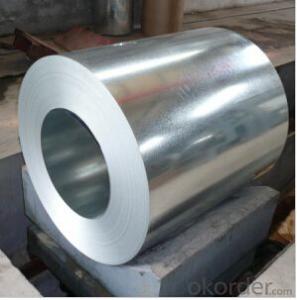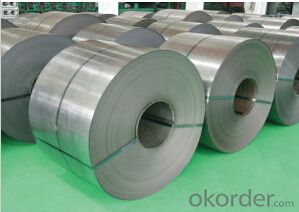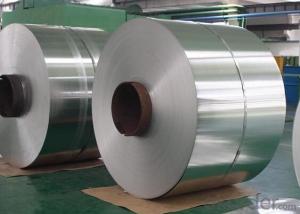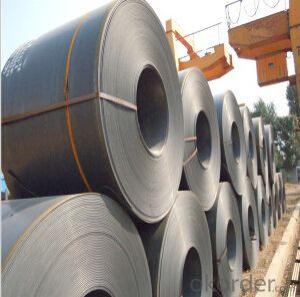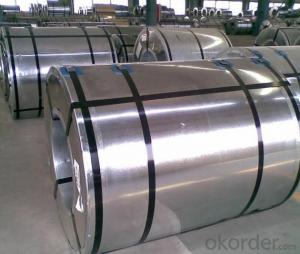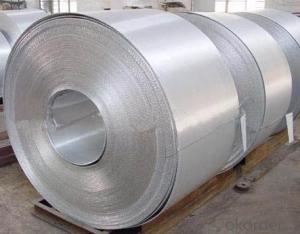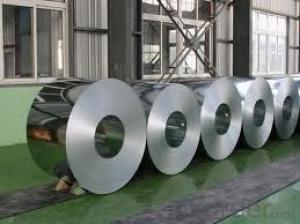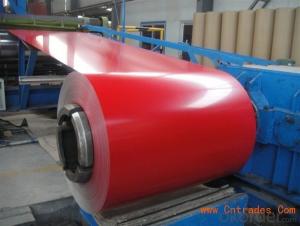Galvanized Steel Coil (S350GD+Z S250GD+ZF) Type: Structural Steel
- Loading Port:
- Tianjin
- Payment Terms:
- TT OR LC
- Min Order Qty:
- 25 m.t.
- Supply Capability:
- 10000 m.t./month
OKorder Service Pledge
OKorder Financial Service
You Might Also Like
Basic Info.
Model NO.:S350GD+Z S350GD+ZF
Surface Treatment:Galvanized
Technique:Cold Rolled
Standard:ASTM,JIS,GB,AISI,DIN,Bs and Others
Steel Grade:S350gd+Z S350gd+Zf
Export Markets:Global
Additional Info.
HS Code:72104900
Production Capacity:10000tons Per Month
Product Description
Brief Introduction:
Commodity name : Hot Dipped Galvanized Steel Coil
Standard we can provide: AISI ASTM BS DIN GB JIS
Grade : DC51D+Z,DC51D+ZF,St01Z,St02Z,St03Z
Zinc Coating:40g-275g/m2
Size we can provide:
Size Range: CRC substrate Thickness: 0.3-3.0mm
CRC substrate Width: 800-1830mm
HRC substrate Thickness:1.8-2.8mm
HRC substrate Width:900-1500mm
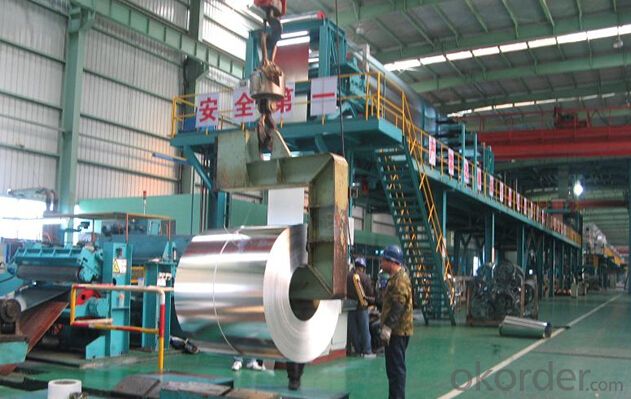
| Grade | Chemical composition % | |||||||||
| C | Si | Mn | P | S | Alta | Ti | Nb | |||
| No more than | No more than | No more than | No more than | No more than | No less than | No more than | No more than | |||
| DC51D+Z,DC51D+ZF | 0.1 | --- | 0.5 | 0.035 | 0.035 | --- | --- | --- | ||
| (St01Z,St02Z,St03Z) | ||||||||||
| Grade | Mechanical properties | plating adhesion | ||||||||
| yield strength | tensile strength | n 90 | r 90 | Elongation % | Plating weight(g/m 2 ) | |||||
| Mpa | Mpa | No less than | No less than | No less than | Bending diameter | |||||
| (a=thickness of slab) | ||||||||||
| L 0 =80mm b=20mm | ||||||||||
| Normal thickness mm | ||||||||||
| ≤ 0.7 | >0.7 | ≤ 140/140 | >140/140~ | >175/175 | ||||||
| 175/175 | ||||||||||
| DC51D+Z(St01Z,St02Z,St03 Z), DC51D+ZF | --- | 270~500 | --- | --- | 20 | 22 | 0a | 1a | 2a | |
| Exposure Test : | Salt Spray Test : | |||||||||
| Environment | GI | Enviroment | GI Average Corrosion | AL-ZN Average Corrosion | ||||||
| Average corrosion | ||||||||||
| g/m2 /y | μ m/y | g/m2/y | um/y | g/m2/y | um/y | |||||
| Tough Marine Climate | 140 | 9.8 | tough Marine Climate | 140 | 9.8 | 16 | 2.2 | |||
| Moderate Marine Climate | 18 | 1.3 | Modeerate Marine Climate | 18 | 1.3 | 4 | 0.54 | |||
| Industrial Climate | 20 | 1.4 | Industrial Climate | 20 | 1.4 | 4.2 | 0.57 | |||
| Countryside Climate | 4 | 0.28 | Countryside Climate | 4 | 0.28 | 1.3 | 0.17 | |||
| Plainness of hot dip galvanized substrate A.2.1 For steel sheet with a specified minimum yield strength less than 260MPa, the maximum plainness tolerance should be in conformity with the stipulations of Table A1. | ||||||||||
| MPa | Nominal width | Plainness (mm) for the nominal thickness as shown below | ||||||||
| Common precise PF.A | High-level precision PF.B | |||||||||
| <0.70 | 0.70~<1.60 | 1.60~3.0 | <0.70 | 0.70~<1.60 | 1.60~3.0 | |||||
| <260 | <1200 | 10 | 8 | 8 | 5 | 4 | 3 | |||
| 1200~<1500 | 12 | 10 | 10 | 6 | 5 | 4 | ||||
| ≥1500 | 17 | 15 | 15 | 8 | 7 | 6 | ||||
| For steel sheet and steel strip with a specified minimum yield strength not less than 260MPa but less than 360MPa,and the grades of DC51+Z/Z DD51D+Z /S550GD+Z/ZF), the maximum plainness tolerance should be in conformity with the stipulations of Table A2. Table A2 | ||||||||||
| MPa | Nominal width | Plainness (mm) for the nominal thickness as shown below | ||||||||
| Common precise PF.A | High-level precision PF.B | |||||||||
| <0.70 | 0.70~<1.60 | 1.60~3.0 | <0.70 | 0.70~<1.60 | 1.60~3.0 | |||||
| 260~<360 | <1200 | 13 | 10 | 10 | 8 | 6 | 5 | |||
| 1200~<1500 | 15 | 13 | 13 | 9 | 8 | 6 | ||||
| ≥1500 | 20 | 19 | 19 | 12 | 10 | 9 | ||||
| Thickness tolerance for hot dip galvanized substrate | ||||||||||
| For steel sheet with a specified minimum yield strength less than 260MPa, the maximum thickness tolerance should be in conformity with the stipulations of Table A6. | ||||||||||
| Nominal thickness | Thickness tolerance while the widths are showed as follows | |||||||||
| Common precise PT.A | High-level precision PT.B | |||||||||
| ≤1200 | >1200~1500 | >1500 | ≤1200 | >1200~1500 | >1500 | |||||
| 0.30~0.40 | ±0.04 | ±0.05 | ±0.06 | ±0.030 | ±0.035 | ±0.040 | ||||
| >0.40~0.60 | ±0.04 | ±0.05 | ±0.06 | ±0.035 | ±0.040 | ±0.045 | ||||
| >0.60~0.80 | ±0.05 | ±0.06 | ±0.07 | ±0.040 | ±0.045 | ±0.050 | ||||
| >0.80~1.00 | ±0.06 | ±0.07 | ±0.08 | ±0.045 | ±0.050 | ±0.060 | ||||
| >1.00~1.20 | ±0.07 | ±0.08 | ±0.09 | ±0.050 | ±0.060 | ±0.070 | ||||
| >1.20~1.60 | ±0.10 | ±0.11 | ±0.12 | ±0.060 | ±0.070 | ±0.080 | ||||
| >1.60~2.00 | ±0.12 | ±0.13 | ±0.14 | ±0.070 | ±0.080 | ±0.090 | ||||
| >2.00~2.50 | ±0.14 | ±0.15 | ±0.16 | ±0.090 | ±0.100 | ±0.110 | ||||
| >2.50~3.00 | ±0.17 | ±0.17 | ±0.18 | ±0.110 | ±0.120 | ±0.130 | ||||
| For steel sheet and steel strip with a specified minimum yield strength not less than 260MPa but less than 360MPa, the thickness tolerance should be in conformity with the stipulations of Table A7. | ||||||||||
| Nominal thickness | Thickness tolerance while the widths are showed as follows | |||||||||
| Common precise PT.A | High-level precision PT.B | |||||||||
| ≤1200 | >1200~1500 | >1500 | ≤1200 | >1200~1500 | >1500 | |||||
| 0.30~0.40 | ±0.05 | ±0.06 | ±0.07 | ±0.035 | ±0.040 | ±0.045 | ||||
| >0.40~0.60 | ±0.05 | ±0.06 | ±0.07 | ±0.040 | ±0.045 | ±0.050 | ||||
| >0.60~0.80 | ±0.06 | ±0.07 | ±0.08 | ±0.045 | ±0.050 | ±0.060 | ||||
| >0.80~1.00 | ±0.07 | ±0.08 | ±0.09 | ±0.050 | ±0.060 | ±0.070 | ||||
| >1.00~1.20 | ±0.08 | ±0.09 | ±0.11 | ±0.060 | ±0.070 | ±0.080 | ||||
| >1.20~1.60 | ±0.11 | ±0.13 | ±0.14 | ±0.070 | ±0.080 | ±0.090 | ||||
| >1.60~2.00 | ±0.14 | ±0.15 | ±0.16 | ±0.080 | ±0.090 | ±0.110 | ||||
| >2.00~2.50 | ±0.16 | ±0.17 | ±0.18 | ±0.110 | ±0.120 | ±0.130 | ||||
| >2.50~3.00 | ±0.19 | ±0.20 | ±0.20 | ±0.130 | ±0.140 | ±0.150 | ||||
| For steel sheet and steel strip with a specified minimum yield strength not less than 360MPa, but less than or equal to 420 MPa, the thickness tolerance should be in conformity with the stipulations of Table A8. | ||||||||||
| Nominal thickness | Thickness tolerance while the widths are showed as follows | |||||||||
| Common precise PT.A | High-level precision PT.B | |||||||||
| ≤1200 | >1200~1500 | >1500 | ≤1200 | >1200~1500 | >1500 | |||||
| 0.30~0.40 | ±0.05 | ±0.06 | ±0.07 | ±0.040 | ±0.045 | ±0.050 | ||||
| >0.40~0.60 | ±0.06 | ±0.07 | ±0.08 | ±0.045 | ±0.050 | ±0.060 | ||||
| >0.60~0.80 | ±0.07 | ±0.08 | ±0.09 | ±0.050 | ±0.060 | ±0.070 | ||||
| >0.80~1.00 | ±0.08 | ±0.09 | ±0.11 | ±0.060 | ±0.070 | ±0.080 | ||||
| >1.00~1.20 | ±0.10 | ±0.11 | ±0.12 | ±0.070 | ±0.080 | ±0.090 | ||||
| >1.20~1.60 | ±0.13 | ±0.14 | ±0.16 | ±0.080 | ±0.090 | ±0.110 | ||||
| >1.60~2.00 | ±0.16 | ±0.17 | ±0.19 | ±0.090 | ±0.110 | ±0.120 | ||||
| >2.00~2.50 | ±0.18 | ±0.20 | ±0.21 | ±0.120 | ±0.130 | ±0.140 | ||||
| >2.50~3.00 | ±0.22 | ±0.22 | ±0.23 | ±0.140 | ±0.150 | ±0.160 | ||||
| For steel sheet and steel strip with a specified minimum yield strength not less than 420MPa, but less than or equal to 900 MPa, the thickness tolerance should be in conformity with the stipulations of Table A9. | ||||||||||
| Nominal thickness | Thickness tolerance while the widths are showed as follows | |||||||||
| Common precise PT.A | High-level precision PT.B | |||||||||
| ≤1200 | >1200~1500 | >1500 | ≤1200 | >1200~1500 | >1500 | |||||
| 0.30~0.40 | ±0.06 | ±0.07 | ±0.08 | ±0.045 | ±0.050 | ±0.060 | ||||
| >0.40~0.60 | ±0.06 | ±0.08 | ±0.09 | ±0.050 | ±0.060 | ±0.070 | ||||
| >0.60~0.80 | ±0.07 | ±0.09 | ±0.11 | ±0.060 | ±0.070 | ±0.080 | ||||
| >0.80~1.00 | ±0.09 | ±0.11 | ±0.12 | ±0.070 | ±0.080 | ±0.090 | ||||
| >1.00~1.20 | ±0.11 | ±0.13 | ±0.14 | ±0.080 | ±0.090 | ±0.110 | ||||
| >1.20~1.60 | ±0.15 | ±0.16 | ±0.18 | ±0.090 | ±0.110 | ±0.120 | ||||
| >1.60~2.00 | ±0.18 | ±0.19 | ±0.21 | ±0.110 | ±0.120 | ±0.140 | ||||
| >2.00~2.50 | ±0.21 | ±0.22 | ±0.24 | ±0.140 | ±0.150 | ±0.170 | ||||
| >2.50~3.00 | ±0.24 | ±0.25 | ±0.26 | ±0.170 | ±0.180 | ±0.190 | ||||
| Width tolerance | ||||||||||
| Nominal width | Width tolerance | Width | ||||||||
FAQ
1.What's your MOQ?
25MT, it is for one container.
2.Do you have QC teams?
Yeah, sure, our QC team is very important, they will keep the quality control for our products.
3. What's your normal delivery time?
Our delivery time about 10-20days for standard sizes, if you have other requirements like hardness and width ,it is about 20-40days. But don't worry ,we also try our best for the delivery time ,because time longer and our cost is higher.
4.Are the products tested before shipping?
Yes, all of our PPGI and GI was qualified before shipping. We test every batch every day.
- Q: What are the different types of steel coil finishing equipment?
- Various industries utilize a range of steel coil finishing equipment to ensure that steel coils are properly prepared and finished according to the desired specifications. Some commonly used equipment includes: 1. Slitting lines, which cut large steel coils into narrower strips using multiple slitting knives at high speeds. These are commonly used in automotive, construction, and packaging industries. 2. Leveling lines, which flatten and straighten steel coils with uneven surfaces or irregularities using leveling rolls and tension control systems. These are commonly used in the manufacturing of appliances, furniture, and metal roofing. 3. Recoiling lines, which rewind steel coils into smaller coils of specific diameter and weight by carefully winding them around a mandrel. These are commonly used in electrical, HVAC, and steel distribution industries. 4. Cut-to-length lines, which cut steel coils into specific lengths as per customer requirements using precision measuring systems and hydraulic shears. These are commonly used in manufacturing, construction, and fabrication industries. 5. Coating lines, which apply protective coatings or finishes on steel coils to enhance corrosion resistance, durability, and appearance. These lines typically consist of cleaning and pre-treatment sections, followed by coating application sections. They are commonly used in automotive, appliances, and construction industries. These examples represent just a few of the available types of steel coil finishing equipment. Each type serves a specific purpose and plays a crucial role in the manufacturing and processing of steel coils for various applications.
- Q: How do steel coils compare to other materials, such as aluminum or copper?
- Steel coils have several advantages over other materials like aluminum or copper. Firstly, steel is generally stronger and more durable, making it suitable for heavy-duty applications. Steel coils also have a higher melting point, which means they can withstand higher temperatures without losing their structural integrity. Additionally, steel is typically more cost-effective and widely available compared to aluminum or copper. However, it's important to note that the choice between these materials depends on the specific requirements of the application, as aluminum and copper may offer advantages in certain scenarios such as electrical conductivity or weight reduction.
- Q: What are the common methods of cutting steel coils?
- The common methods of cutting steel coils include shearing, slitting, and laser cutting. Shearing involves using a machine with two blades to cut through the coil. Slitting involves passing the coil through a set of rotating circular blades to create narrower strips. Laser cutting uses a high-powered laser beam to cut through the steel coil with precision.
- Q: i have a computer chair where the metal part that attachs the top part to the bottom with wheels has cracked around half of the assembly. my dad said it might be able to be repaired with jb weld. can jb weld fix it? how strong is jb weld? is it as strong as steel?
- ...
- Q: What are the different methods of levelling steel coils?
- There are several methods of leveling steel coils, including roller leveling, stretcher leveling, and temper leveling.
- Q: How are steel coils used in the manufacturing of conveyor belts?
- Steel coils are used in the manufacturing of conveyor belts as they provide the necessary strength and durability required for transporting heavy loads. The steel coils are processed and shaped into strong, flat strips that are then woven or bonded onto the belt's surface, enhancing its strength and resistance to wear and tear. This ensures that the conveyor belt can efficiently and reliably carry materials across various industries, including mining, logistics, and manufacturing.
- Q: What are the environmental impacts of producing steel coils?
- The production of steel coils has several environmental impacts. Firstly, it involves the extraction of iron ore, which requires mining activities. These mining operations can lead to deforestation, habitat destruction, and soil erosion. Additionally, the extraction and processing of iron ore require large amounts of energy, contributing to greenhouse gas emissions and air pollution. Furthermore, the production of steel coils involves several stages, such as smelting and refining, which are energy-intensive and emit significant amounts of carbon dioxide, sulfur dioxide, and nitrogen oxides. These emissions contribute to air pollution, acid rain, and climate change. Water consumption is another notable environmental impact. Steel production requires large volumes of water for cooling and processing purposes. This high water demand can strain local water resources and potentially lead to water scarcity or pollution if not managed properly. Moreover, the steel industry generates substantial amounts of waste and by-products, such as slag, dust, and sludge. Proper disposal and treatment of these waste materials are crucial to prevent soil and water contamination. Lastly, transportation plays a role in the environmental impact of steel coil production. The transportation of raw materials and finished products can contribute to carbon emissions and air pollution, especially if long distances are involved. To mitigate these environmental impacts, various measures can be taken. Implementing more efficient production processes, such as recycling and using renewable energy sources, can reduce energy consumption and emissions. Additionally, improving waste management practices, investing in water conservation technologies, and optimizing transportation logistics can help minimize the environmental footprint of steel coil production.
- Q: What are the different types of steel coil surface treatments for outdoor applications?
- For outdoor applications, there are several commonly used surface treatments for steel coils that enhance durability, corrosion resistance, and appearance. Examples of these treatments include: 1. Galvanized: This treatment involves applying a layer of zinc to the steel surface, providing excellent corrosion resistance. Galvanized steel coils have a shiny, silver appearance. 2. Galvalume: Galvalume is a combination of aluminum and zinc applied to the steel surface, offering superior corrosion resistance compared to galvanized steel. Galvalume steel coils have a duller, matte finish. 3. Painted: Steel coils can be painted with various coatings to enhance appearance and protect against corrosion. The paint can be applied in single or multiple layers, depending on the desired level of protection. Painted steel coils are available in a wide range of colors and finishes. 4. Powder Coated: This type of paint coating is applied as a powder and then cured under heat, resulting in a durable and long-lasting finish. Powder coated steel coils are resistant to chipping, scratching, and fading, making them suitable for outdoor applications. 5. Organic Coated: Organic coatings, such as PVC or PVDF, are applied to steel coils to provide additional protection against corrosion and weathering. These coatings are commonly used in architectural applications where aesthetics and durability are important. These various surface treatments for steel coils offer different levels of protection and aesthetic options for outdoor applications. The choice of treatment depends on factors such as the intended use, environmental conditions, and desired appearance.
- Q: How are steel coils used in the production of storage systems?
- Steel coils are used in the production of storage systems by being formed into sheets or strips, which are then shaped and welded to create the framework and shelves of the storage units. The high strength and durability of steel make it an ideal material for supporting heavy loads and ensuring the longevity of storage systems.
- Q: What are the challenges in storing and handling steel coils?
- Storing and handling steel coils pose several challenges due to their size, weight, and potential risks associated with their transportation and storage. Some of the challenges include: 1. Space requirements: Steel coils are generally large and bulky, requiring ample storage space. Finding suitable storage facilities that can accommodate the size and weight of the coils can be a challenge, especially in urban areas where space is limited. 2. Weight and handling: Steel coils can weigh several tons, making them difficult to handle safely. Specialized equipment such as cranes or forklifts with sufficient lifting capacity is necessary for moving and positioning the coils without causing damage or injury. 3. Stackability: Storing steel coils in a safe and efficient manner requires careful consideration of their stackability. Coils must be stacked in a way that prevents deformation or damage to the lower coils, ensuring stability and minimizing the risk of toppling. 4. Corrosion prevention: Steel coils are susceptible to corrosion, especially when exposed to moisture or harsh environmental conditions. Implementing proper corrosion prevention measures, such as protective coatings or climate-controlled storage, is crucial to maintain the quality and integrity of the coils. 5. Safety risks: Handling steel coils can be dangerous, as they can shift unexpectedly during transportation or storage. This poses a risk to workers involved in the handling process. Adequate training, appropriate personal protective equipment (PPE), and strict safety protocols are essential to minimize the potential for accidents or injuries. 6. Transportation challenges: Transporting steel coils from manufacturing facilities to storage facilities or end-users can be logistically complex. Coordinating the loading, securing, and unloading of the coils onto trucks or shipping containers requires careful planning and adherence to safety regulations. 7. Quality control: Steel coils must be stored and handled in a way that maintains their quality. Any mishandling or improper storage conditions can lead to deformations, scratches, or other defects that can affect the performance and value of the steel. Overall, the challenges in storing and handling steel coils require attention to detail, proper equipment, and adherence to safety protocols to ensure the integrity of the product, the safety of workers, and the efficiency of operations.
Send your message to us
Galvanized Steel Coil (S350GD+Z S250GD+ZF) Type: Structural Steel
- Loading Port:
- Tianjin
- Payment Terms:
- TT OR LC
- Min Order Qty:
- 25 m.t.
- Supply Capability:
- 10000 m.t./month
OKorder Service Pledge
OKorder Financial Service
Similar products
Hot products
Hot Searches
Related keywords
